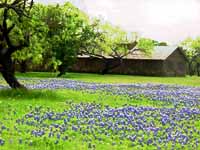Texas Plant Information Database

TPID Glossary
aeolin soil sandy soil deposited
by wind
alluvial soil eroded soil deposited by running water
annual plants that complete their entire life cycle in one year
apomictic seeds viable seeds which are unfertilized
aspect geographic orientation toward preferred compass direction
biennial plants that complete their live cycle in two years
biomass weight of living material
clay soil consists of particles less than 0.002 mm, plastic when
moist, extremely hard when dry
colluvial soil eroded soil deposited on hillsides
component a non-dominant member of a plant community
coppices sprouts from shoots or root suckers to form thickets or groves
deciduous plants which shed their leaves at least once a year
dominant the most common, often largest species in a community
epiphytic a non-parasitic plant that grows on the surface
of other plants
erosion wearing away of soil by the action of water or wind
evergreen plants having green leaves throughout the year
facultative plants that occur equally in wetlands or non-wetlands
facultative upland plants that usually occur in non-wetlands, but
occasionally occur in wetlands
facultative wetland plants that occur in wetlands, but occasionally
are found in non-wetlands
forb an herb other than a grass
gravelly soil consists of particles larger than 2.0 mm, small pebbles
habitat the place or kind of place in which an organism or a community
or association of organisms is found
herb a small plant without woody stems or roots
loamy soil consists of a mixture of sand, silt, and clay, crumbles
easily
native plants are are indigenous (i.e. innate or natural)
to one or more vegetational regions and are adapted to local conditions
naturalized plants are not native (i.e. foreign) to a vegetational region
but can adapt to local conditions; only a few useful, but non-noxious naturalized plants are
included in this database
obligate upland plants that almost always occur in non-wetlands
obligate wetland plants that almost always occur in wetlands
perennial plants that grow and reproduce for many years
pH numerical value between 0 and 14 indicating degree of acidity
or alkalinity with 7.0 being neutral, below 7.0 acidic, and above 7.0 alkaline
phreatophytic describes a deep-rooted plant that obtains its water
supply from groundwater
rhizomes stems growing underground producing new shoots
rush marsh plant with cylindrical often hollow stems of the family
Juncaceae
spp. species; a group of closely related individuals within the same
genus
sandy soil consists of particles from 0.05 to 2.0 mm, gritty texture
sedge tufted grasslike marsh plant often with triangular stems of
the family Cyperaceae
silty soil consists of particles from 0.002 to 0.05 mm, flour-like
texture
stolons stems growing along the ground producing new upright plants
with roots
succulent plants that are thick, fleshy, soft and, juicy due to the
presence of water-storing tissues (e.g., cacti and yuccas)
suffrutescent somewhat shrubby; herbaceous and annual upper parts, woody at the base
tillers new plants growing from the base of an old plant
TPID Texas Plant Information Database